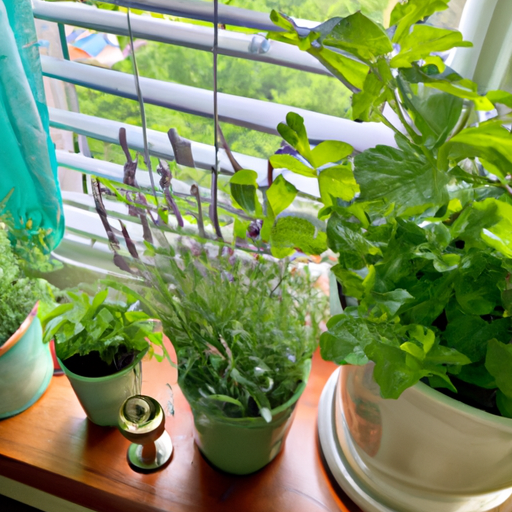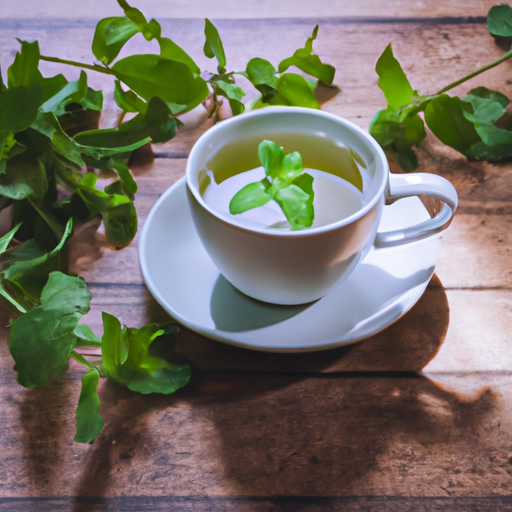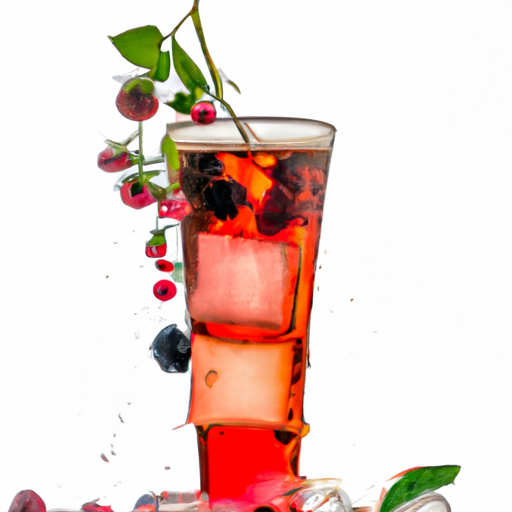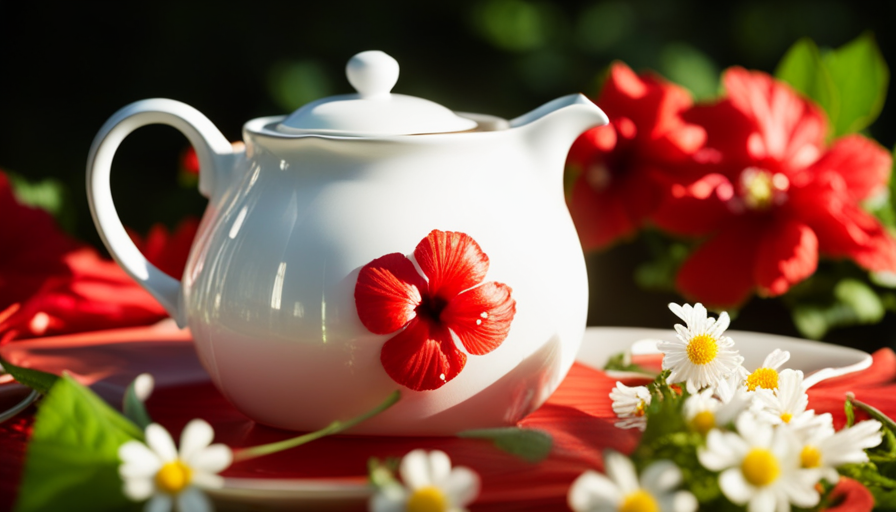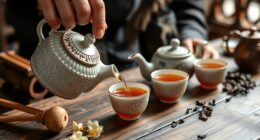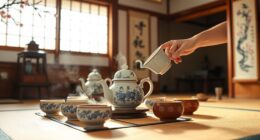So, you’re a tea lover like me, huh? Well, let me tell you something – there’s nothing quite like the satisfaction of sipping on a fresh cup of herbal tea that you’ve grown right in your own backyard. Trust me, it’s a whole new level of tea experience.
In this article, I’m going to share with you my tried and true methods for growing herbal tea at home. From choosing the perfect tea herbs for your garden to brewing the most delightful cup of tea, I’ve got you covered. And let me tell you, it’s easier than you might think.
So, if you’re ready to elevate your tea game and enjoy the delicious flavors of homegrown herbal tea, then stick around. Get your green thumbs ready and let’s dive into the world of growing herbal tea at home. It’s time to sip and savor the fruits of your labor.
Key Takeaways
- Choose herbs based on taste and health needs
- Experiment with brewing techniques and steeping times
- Find the perfect balance of flavors
- Use a variety of herbs for different flavors
Choose the Right Tea Herbs for Your Garden
If you want to create your own delicious and soothing herbal tea blend, it’s essential to choose the right tea herbs for your garden. Growing tea in different climates offers a wide range of possibilities for tea enthusiasts.
Whether you live in a hot and sunny region or a cooler and more temperate one, there are tea herbs that can thrive in your specific climate. By growing your own tea, you can ensure that it’s fresh, organic, and free from any harmful additives.
Additionally, there are numerous benefits to growing your own tea. You can enjoy the satisfaction of knowing exactly where your tea comes from and the opportunity to experiment with different flavors and blends.
Now that you know the importance of choosing the right tea herbs, let’s dive into how to create the ideal growing environment.
Create the Ideal Growing Environment
To cultivate a thriving garden of aromatic plants, it’s crucial to establish a conducive environment that promotes their growth, such as maintaining a consistent humidity level of 50-70%. Indoor gardening allows you to have control over the growing conditions, ensuring optimal growth for your tea herbs. Organic gardening practices can be easily incorporated into your indoor setup, allowing you to grow herbal tea free from harmful chemicals. Creating the ideal growing environment involves providing sufficient light, temperature, and air circulation. Consider using grow lights or placing your plants near a sunny window to ensure they receive adequate sunlight. Maintaining a temperature between 65-75 degrees Fahrenheit and proper air circulation will help prevent diseases and keep your plants healthy. With the right growing conditions, you can successfully grow and nurture your tea herbs, providing you with a fresh and aromatic supply for your homemade herbal teas.
Plant and Nurture Your Tea Herbs
Creating an optimal environment for your aromatic plants is essential for their healthy growth and development. When planting and nurturing your tea herbs, it’s important to consider companion plants that can enhance their growth. For example, chamomile and mint are great companions for herbal tea plants, as they repel pests and provide shade.
Additionally, incorporating natural remedies into your care routine can promote the overall health of your herbs. For instance, using neem oil or garlic spray can help deter pests and prevent diseases. Regular watering, well-drained soil, and adequate sunlight are also crucial for their proper growth.
By providing a nurturing environment and utilizing natural remedies, you can ensure that your tea herbs thrive. Once your herbs have reached maturity, it’s time to move on to the next step of harvesting and drying your herbs, which I will discuss in the following section.
Harvesting and Drying Your Herbs
Once your tea herbs have reached maturity, it’s time to embark on the rewarding journey of harvesting and drying them to preserve their flavors and aromas. To ensure the best quality, follow these steps:
-
Harvesting: Choose a sunny day to harvest your herbs when the essential oils are at their peak. Use sharp scissors to cut the stems close to the base, taking care not to damage the plant.
-
Drying Techniques: There are several methods to dry your herbs, such as air drying, oven drying, or using a dehydrator. Air drying is the simplest and most traditional method. Bundle the stems together, hang them upside down in a cool, well-ventilated area, and let them dry for about 1-2 weeks.
-
Preserving the Aroma: To preserve the full aroma of your herbs, harvest and dry them just before they flower. This is when the essential oils are most concentrated.
Once your herbs are dried, it’s time to move on to the subsequent section about proper storage and preservation, ensuring your herbal tea remains fresh and flavorful.
Proper Storage and Preservation
Get ready to experience the mind-blowing secret to keeping your precious herbs fresh and flavorful for an eternity! Proper storage is crucial to maintaining the quality of your harvested herbs.
To store fresh herbs, start by gently washing and drying them thoroughly. Remove any damaged or wilted leaves before placing them in an airtight container. You can either store them whole or chop them finely, depending on your preference. It’s important to prevent mold growth, so make sure the herbs are completely dry before sealing the container.
Keep the container in a cool, dark place to maintain the flavor and potency of the herbs.
Now that you know how to store your herbs properly, let’s move on to brewing the perfect cup of herbal tea.
Brewing the Perfect Cup of Herbal Tea
To truly savor the exquisite flavors and soothing aromas of a perfectly brewed cup of tea, it’s essential to master the art of steeping. Exploring different tea flavors is an exciting journey that opens up a world of possibilities. From calming chamomile to invigorating peppermint, herbal teas offer a wide range of tastes and health benefits. To ensure the best brewing experience, follow these simple steps:
- Choose high-quality loose leaf tea or tea bags.
- Heat water to the appropriate temperature for the specific tea.
- Steep the tea for the recommended time, using the table below as a guide:
| Tea Type | Water Temperature | Steep Time |
|---|---|---|
| Chamomile | 200°F | 5-6 minutes |
| Peppermint | 212°F | 3-5 minutes |
| Lemon Ginger | 195°F | 4-5 minutes |
By brewing your herbal tea with care, you can unlock its full potential. Experiment with flavor combinations to create your own unique blends that suit your taste preferences.
Experiment with Flavor Combinations
Now that you’ve mastered the art of brewing the perfect cup of herbal tea, it’s time to take your tea game to the next level by experimenting with flavor combinations. Mixing different herbs and spices can create unique tea blends that cater to your taste preferences and health needs.
Here are some exciting ideas to get you started:
- Chamomile and lavender: A calming blend that promotes relaxation and better sleep.
- Mint and lemon: Refreshing and invigorating, perfect for a mid-afternoon pick-me-up.
- Ginger and turmeric: A powerful anti-inflammatory combination that boosts immunity.
- Hibiscus and rosehip: Tart and tangy, packed with antioxidants for a healthy glow.
- Rooibos and cinnamon: A warming blend that aids digestion and regulates blood sugar.
By exploring these flavor combinations, you not only expand your tea repertoire but also reap the health benefits of different herbal tea combinations. So, go ahead and experiment with these unique blends to create your signature cup of homegrown herbal tea.
Next, let’s move on to how you can share and enjoy your delightful creations.
Share and Enjoy Your Homegrown Herbal Tea
Indulge in the blissful experience of savoring and sharing your own handcrafted elixirs, unlocking the secret to pure herbal delight.
Growing herbal tea at home not only allows you to experiment with flavor combinations but also offers numerous health benefits. Herbal teas are known for their soothing properties and can help with digestion, relaxation, and boosting the immune system.
To incorporate herbal tea into your daily routine, start by choosing a variety of herbs that suit your taste and health needs. Experiment with different brewing techniques and steeping times to find the perfect balance of flavors.
Enjoy a cup of herbal tea in the morning to kickstart your day or in the evening to unwind and relax. Remember to share your homegrown herbal tea with friends and family, spreading the joy and benefits of this delightful beverage.
Frequently Asked Questions
Can I grow herbal tea in pots or do I need a garden?
Yes, you can grow herbal tea in pots. Container gardening for herbal tea is a great option, offering the benefits of growing your own tea indoors. It’s convenient, space-saving, and allows for easy maintenance and harvesting.
How long does it take for tea herbs to grow from seed to harvest?
Tea herbs can be grown in containers or in the ground. It takes about 2-3 months for tea herb seeds to grow from seed to harvest. The best time to plant tea herb seeds is in the spring or early summer.
Can I use any type of soil to grow tea herbs or is special soil required?
Using special soil is essential for growing tea herbs. Different types of soil can affect the flavor and quality of the herbal tea. In fact, studies have shown that using the right soil can enhance the medicinal properties and taste of the tea.
Are there any pests or diseases that commonly affect tea herbs and how can I prevent them?
Common pests and diseases in herbal tea plants include aphids, spider mites, and powdery mildew. To control them, regularly inspect plants, remove infected parts, and use organic insecticides or neem oil.
Can I use fresh tea herbs right away or do they need to be dried first?
You can use fresh tea herbs right away for making herbal tea, but drying them first enhances their flavor. To properly dry tea herbs, hang them upside down in a cool, dry place until they are fully dried.
Conclusion
In conclusion, growing herbal tea at home is a rewarding and fulfilling experience. By following the steps outlined in this article, you can create your own little tea garden and enjoy the freshest and most flavorful herbal teas.
So why not give it a try? Imagine sipping on a cup of tea made from your very own homegrown herbs. Isn’t that a delightful thought? Start your herbal tea journey today and discover the joy of cultivating and enjoying your own homemade brews.

